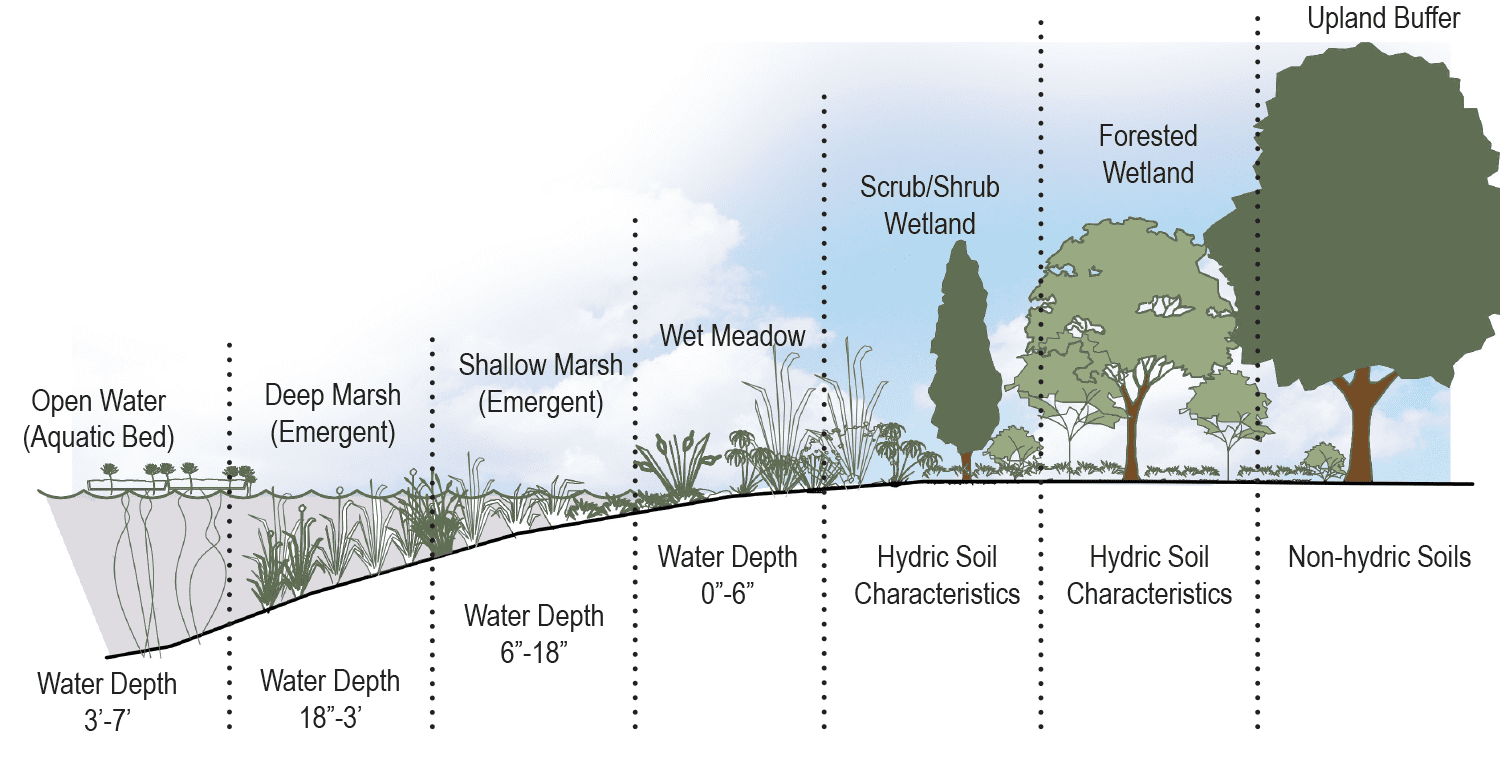Though not as challenging as streambanks, wetland and pond edges do pose challenges for the establishment of healthy plant material.
Fluctuating water levels make for much of the variability in the success of these planting approaches.
NOTE: Wetland planting should utilize strictly native plants, and plants have a tendency to migrate in these locations.
- Common invasive species in wetland and pond areas include reed canary grass, common reed, purple loosestrife, and cattails. If the invasives species cover is greater than 30% of the area, this condition should be remedied through removal of invasives and replanting of native species, especially during the establishment period. If possible, invasives should be eradicated during the first month of discovery.
- If design species continue to fail to become dominant, soil pH, soil permeability, hydrology, or salt content may be incorrect for the selected species. Recommend consulting designer for plant material adjustment and implement soil testing.
- No more than 10% of the wetland or streambank area should be bare ground, and should not observe loss of more than 20% of a single plant species by number of plants.
Lower Slopes
- Plants should be able to tolerate poor water quality for a short period of time and filter pollutants.
- Bank stabilization may be required, especially on newly constructed wetlands. Consider using live stakes for planting where woody plant material is appropriate.
- Planting in this area can be hydroseeded in low-water seasons. Plugs and live-stakes are preferred.
- In general, due to high failure rates in these areas, smaller plant material should be utilized to minimize costs.
Upper Slopes
- Upper edges of the riparian zone and higher can be planted for more aesthetic purposes.
- Larger plant material can be used in these areas.
- Seeding can be performed with greater likelihood of success in these areas.
Deep Emergent Plant List
- WATER LILY Nymphaea spp.
- YELLOW POND LILY Nuphar lutea
- AMERICAN LOTUS Nelumbo lutea
- WATER CANNA Thalia dealbata
Wet Meadow to Emergent Shallow Plant List
TREES
- BALD CYPRESS Taxodium distichum
SHRUBS
- BOTTLEBRUSH BUCKEYE Aesculus parviflora
- SUMMERSWEET Clethra alnifolia
- REDTWIG DOGWOOD Cornus sericea
HERBACEOUS PERENNIALS
- FOX SEDGE Carex vulpinoidea
- RUSH Juncus effusus
- BULRUSH Scirpus atrovirens
- PALM SEDGE Carex muskingumensis
- IRIS Iris virginica, I. fulva
- HIBISCUS Hibiscus moscheutos
- CARDINAL FLOWER Lobelia cardinalis
- MONKEY FLOWER Mimulus ringens
- ARROW ARUM Peltandra virginica
- BLUESTARS Amsonia illustris
- BUTTONBUSH Cephalanthus occidentalis
- WATER CANNA Thalia dealbata
- PICKEREL WEED Pontederia cordata
- ARROWHEAD Sagittaria latifolia
- JOE-PYE WEED Eupatorium maculatum
Forested Wetland Plant List
TREES
- BLACK TUPELO Nyssa sylvatica
- TULIPTREE Liriodendron tulipifera
- SWAMP WHITE OAK Quercus bicolor
SHRUBS
- WINTERBERRY Ilex verticillata
- VIRGINIA SWEETSPIRE Itea virginica
HERBACEOUS PERENNIALS
- BLUEJOINT GRASS Calmagrostis canadensis
- FOWL MANNA GRASS Glyceria striata
- FRINGED SEDGE Carex crinita
- GREAT ANGELICA Angelica atropurpurea
- SNEEZEWEED Helenium autumnale
- GREAT BLUE LOBELIA Lobelia siphilitica
- MONKEY FLOWER Mimulus ringens
- SWAMP MILKWEED Asclepias incarnata

